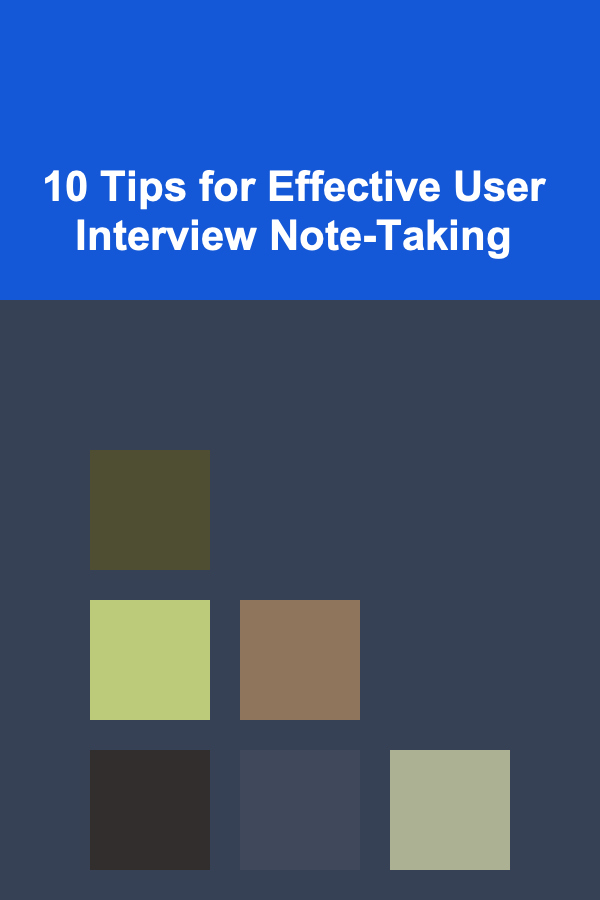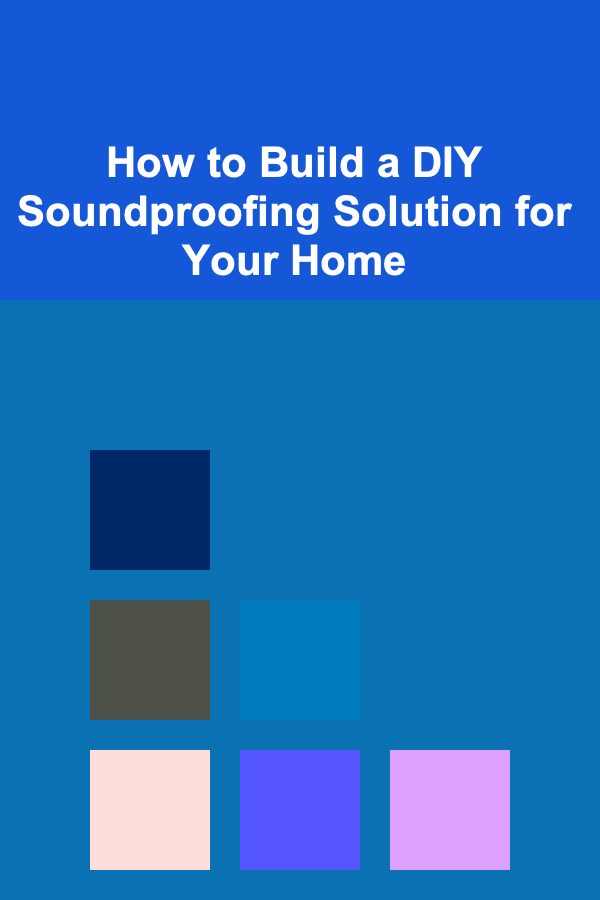
10 Tips for Effective User Interview Note-Taking
ebook include PDF & Audio bundle (Micro Guide)
$12.99$10.99
Limited Time Offer! Order within the next:

User interviews are a fundamental aspect of understanding your target audience, gathering qualitative data, and ensuring your product or service meets user needs. However, the effectiveness of these interviews hinges not only on the questions asked and the responses provided but also on how well the information is recorded and organized. Effective note-taking during user interviews ensures that the insights gained can be easily reviewed, shared, and applied to design or development processes.
In this article, we will delve into ten tips that can elevate your user interview note-taking skills, ensuring you capture the most critical insights while maintaining clarity and consistency. Whether you're conducting interviews for user research, product design, or UX testing, these strategies will help streamline the process and make your findings actionable.
Be Prepared Before the Interview
Preparation is key to conducting a smooth and productive user interview. Before you even sit down with the user, make sure you are prepared for both the interview and the note-taking process. Here are some steps to ensure you're ready:
- Review Your Interview Script: Familiarize yourself with the questions and flow of the interview. This allows you to anticipate key areas where you need to focus your note-taking.
- Choose Your Tools: Decide whether you will be taking notes on paper, a laptop, or using a tablet. Digital tools like Google Docs or Evernote allow for easy editing and sharing, while handwritten notes can sometimes be faster for capturing nuanced reactions.
- Set Up Your Recording Equipment: If you're recording the interview for later reference, make sure your audio or video equipment is ready to go. This lets you focus on the conversation while ensuring that you don't miss key details.
By being prepared, you ensure that you don't lose valuable insights due to distractions or technical issues.
Focus on Key Insights Rather Than Word-for-Word Transcription
During an interview, it's easy to get caught up in trying to write down everything the user says. However, taking a word-for-word transcript is rarely useful and can detract from the flow of the conversation. Instead, focus on:
- Key Quotes: Write down direct quotes that encapsulate important feelings, frustrations, or insights. These can add depth and context to your findings.
- Themes and Patterns: Rather than capturing every detail, look for recurring themes or patterns in the user's responses. This can give you a better understanding of overarching user needs and pain points.
- Contextual Notes: Jot down quick notes that help explain the context behind what the user is saying. For example, "User seems frustrated with slow loading times on mobile" provides more context than simply noting "User mentioned loading times."
By focusing on these key points, you can save time while still capturing the most critical information.
Use a Structured Template or Framework
Having a structured note-taking template or framework can significantly improve the consistency and clarity of your notes. A consistent structure will also make it easier to analyze and share findings after the interview. A few frameworks you could use include:
- The 5 W's: Note down who, what, when, where, and why for each key point.
- User Goals and Pain Points: Divide your notes into categories such as goals, frustrations, behaviors, and preferences. This way, you can easily map each insight back to a specific user need.
- Problem-Solution: Split your notes into two columns: one for the problem the user is facing and one for their suggested solutions or responses.
By organizing your notes with a predefined structure, you ensure that the information is not only useful but also easy to review.
Don't Overwhelm Yourself with Notes
It's tempting to write down every word that is said during an interview, but this can quickly overwhelm you and dilute the quality of your notes. Instead, focus on capturing the most impactful information:
- Key Points: Write down the most important insights that directly relate to your research objectives.
- Emotional Responses: Pay special attention to moments when users show strong emotions---whether it's frustration, joy, or confusion. These moments are often linked to pain points or unmet needs.
By capturing only the most relevant information, you ensure that your notes are concise, actionable, and easy to review.
Use Abbreviations and Shortcuts
To keep up with the pace of the conversation, it's helpful to use abbreviations or shorthand when note-taking. Develop your own system of shorthand for common terms or phrases that you'll encounter during multiple interviews. For example:
- UX for user experience
- UI for user interface
- PT for pain points
- Goals for user goals
- NPS for Net Promoter Score
Using these shortcuts allows you to quickly jot down key insights without losing the flow of the conversation.
Record the User's Non-Verbal Cues
While verbal responses are important, non-verbal cues can also provide rich insights that shouldn't be overlooked. Pay attention to the user's body language, facial expressions, and tone of voice. For example:
- Facial Expressions: If the user smiles or frowns during a certain topic, it may indicate a positive or negative reaction to that aspect.
- Body Language: If the user becomes fidgety or crosses their arms when discussing a particular feature, this might indicate discomfort or frustration.
- Tone of Voice: A change in tone, like frustration or excitement, can offer additional context to their words.
Make note of these cues in your interview notes (e.g., "User looks frustrated when talking about long form fields") to help add depth to your insights.
Don't Interrupt the User
While taking notes, it's tempting to interrupt the user to clarify something or to add your own thoughts. However, it's important to let the user speak freely. Interrupting can disrupt the flow of the interview and may lead to incomplete insights. Instead:
- Pause Before Responding: If you're unsure of something the user said, jot it down and ask for clarification later. This allows the user to finish their thoughts without feeling interrupted.
- Ask Follow-Up Questions: If needed, ask open-ended follow-up questions after they've finished speaking, which can help you gather more information without cutting them off.
By listening attentively without interruptions, you allow the user to feel heard, which can lead to more honest and insightful responses.
Use Color Coding or Highlighting for Emphasis
When reviewing your notes later, it can be helpful to use color coding or highlighting to emphasize specific themes or categories. For example:
- Red: Pain points or areas of frustration
- Green: Positive user feedback or successful features
- Yellow: Ideas or suggestions from users
- Blue: Areas requiring further exploration or clarification
This method allows you to quickly scan your notes and focus on specific areas when analyzing your findings.
Review Your Notes Immediately After the Interview
The value of your notes can diminish over time, so it's essential to review them right after the interview while the details are still fresh in your mind. During this review, you can:
- Fill in Gaps: If you missed anything during the interview or didn't fully capture a user's response, you can quickly add additional details.
- Reflect on the Insights: Take a moment to reflect on the key insights you captured and how they align with your research goals.
- Clarify Ambiguities: If there are any unclear notes or abbreviations, now is the time to clarify them before you forget the context.
This review process ensures that your notes are thorough and accurate, which will be crucial when synthesizing your findings.
Share and Collaborate on Your Notes
After you've reviewed and organized your notes, share them with team members or stakeholders who may benefit from the insights. Collaborating with others allows for:
- Cross-Referencing: Other team members may have noticed things you didn't, helping to fill in gaps and build a more complete picture of the user's needs.
- Synthesizing Findings: By sharing your notes, you can collaborate on synthesizing the key insights, identifying patterns, and coming up with actionable recommendations.
- Building Consensus: Sharing your notes with others helps ensure that everyone is on the same page regarding the user's needs and preferences, which can guide the next steps in the design or development process.
Collaboration ensures that the insights gained from the interview are maximized and leveraged effectively by your team.
Conclusion
Effective note-taking is a critical skill for conducting successful user interviews. By following these ten tips---preparing ahead of time, focusing on key insights, using structured templates, and ensuring thorough post-interview review---you can capture valuable data that will help inform your product or service design. Remember, the goal is not only to record information but to do so in a way that is organized, clear, and actionable. With these strategies, you'll be able to transform raw interview data into meaningful insights that drive your projects forward.
Reading More From Our Other Websites
- [Personal Investment 101] How to Use Index Funds for Passive Investing
- [Personal Financial Planning 101] How to Create a Budget That Works for You
- [Organization Tip 101] The Importance of Regular Toilet Flapper Maintenance
- [Organization Tip 101] How to Organize Your Bathroom Cabinets for Maximum Space
- [Home Party Planning 101] How to Curate the Perfect Party Playlist for the Best Vibe
- [Survival Kit 101] The Ultimate Survival Kit for College Students Facing Campus Power Outages
- [Home Renovating 101] How to Turn Your Attic Into Usable Space
- [Tie-Dyeing Tip 101] Best Tie‑Dye Stencil Designs: Level Up Your Creative Projects
- [Home Storage Solution 101] How to Organize Your Garage with Budget-Friendly Storage Ideas
- [Personal Financial Planning 101] How to Protect Your Wealth with Insurance Strategies

How to Build a DIY Soundproofing Solution for Your Home
Read More
How to Pet-Proof Your Furniture for Long-Term Care
Read More
How to Properly Maintain Your Home's Fireplace
Read More
How To Recognize Signs of Anxiety in Your Dog
Read More
Creating Multiple Streams of Income for FIRE
Read More10 Tips for Choosing the Right Professional Development Expense Tracker
Read MoreOther Products

How to Build a DIY Soundproofing Solution for Your Home
Read More
How to Pet-Proof Your Furniture for Long-Term Care
Read More
How to Properly Maintain Your Home's Fireplace
Read More
How To Recognize Signs of Anxiety in Your Dog
Read More